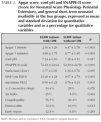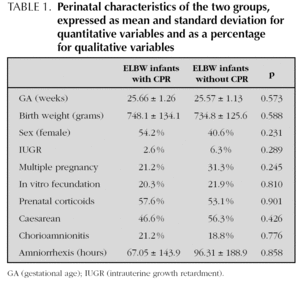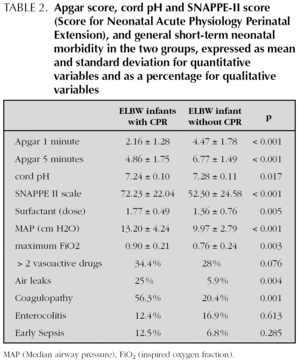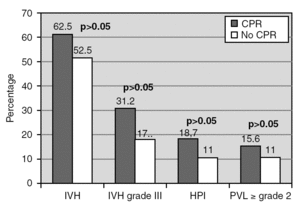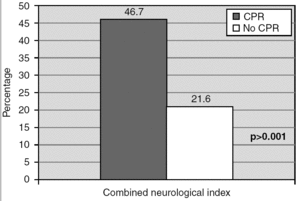Introduction
In recent years there has been a marked increase in the number of extremely low birth weight (ELBW) infants, weighing under 1,000 grams and with a gestational age under 28 weeks. The guidelines for cardiopulmonary resuscitation of neonates do not stipulate any specific recommendations that take weight or gestational age into account. Therefore, in the population of ELBW infants, the same indications for the start of profound or advanced cardiopulmonary resuscitation are used as in all other neonates, i.e. cardiac massage and/or adrenalin and other drugs 1-3. The frequency of advanced cardiopulmonary resuscitation in this ELBW group varies between 6 and 12.5 %, according to the literature 4-7.
The vulnerability of the ELBW infant means that CPR may involve greater mortality and high short-term morbidity. In general, in ELBW infants, cardiac massage and/or adrenalin administration are seen as risk factors for poor survival and severe intraventricular haemorrhage 8,9. However, since data in the literature on morbi-mortality in relation to advanced resuscitation in this population group are scant4,5, the risk/benefit relationship of CPR in this age group is not well established. The study of short- and long-term neurological morbidity associated with CPR in ELBW infants is important not only to optimize indications, guidelines and limits of CPR in these neonates, but to establish whether the CPR at birth leads to a specific group of ELBW infants at high neurodevelopmental risk.
The aim of this study was to examine whether the ELBW infants, under 28 weeks gestational age and weighing under 1,000 grams at birth, who need CPR in the delivery room, have worse survival and greater neurological and general short-term morbidity during the neonatal period.
Material and methods
Design
A retrospective cohorts study, conducted by exhaustive review of medical records.
Subjects
We included all neonates weighing under 1,000 grams at birth and under 28 weeks gestational age (estimated by amenorrhea) born at our hospital between September 2000 and September 2004. Neonates with major congenital defects and those without a proactive perinatal attitude in the delivery room were excluded.
Setting
The study was conducted in a university hospital which attends the annual birth of 10,500 infants, 1.4 % of them premature under 1,500 grams. In the period of time covered by the study, the standard practice of CPR in ELBW infants remained unchanged at the hospital. The resuscitation of this group of neonates was performed by a staff neonatologist, one or two doctors in training and a specialized nurse in neonatal resuscitation.
Main objective
To examine whether ELBW infants, under 28 weeks gestational age and weighing under 1,000 grams at birth, who needed CPR in the delivery room, had worse survival and greater short-term neurological and general morbidity during the neonatal period. Primary end-points were established as survival at discharge and initial neurological damage (severe intraventricular haemorrhage, haemorrhagic periventricular infarction and cystic periventricular leucomalacia). In addition, a combined index of neurological morbidity, in which the three disorders mentioned were included, was established. Other secondary points examined were haemodynamic instability, the need for exogenous pulmonary surfactant, the need for mechanical ventilation, the persistence of ductus arteriosus with clinical repercussions, air leaks, coagulopathy, early sepsis and necrotizing enterocolitis. Further secondary points examined were the hospital stay, time on oxygen therapy, bronchopulmonary dysplasia, total duration of mechanical ventilation, inotropic support, prevalence retinopathy of prematurity needing lasertherapy, age at which enteral nutrition began and when exclusive enteral nutrition was reached, and weight and head perimeter on discharge.
The population included in the study was divided into two groups: 1) Those who needed CPR in the delivery room; 2) those who did not require it, this group was used as the control one.
Operating Definitions
Gestational age was based on the obstetric estimation of the last menstrual period and/or the earliest ultra-sound examination. We defined CPR as resuscitation in which chest compressions and/or epinephrine were administered. Intubation of ELBW infants in our hospital is decided in each individual case, depending on the presence of respiratory distress and on cardiopulmonary status. Surfactant was administer with an early therapy criterion on entry into the neonatal intensive care unit, but never prophylactic in the delivery room. Early neurological morbidity was diagnosed on the basis of the ultrasonographic findings. Intraventricular haemorrhage (IVH) was appraised with the Volpe classification 10,11, and periventricular leucomalacia (PVL) by the modified classification of de Vries and colleagues 12, taking as grade 1 the presence of persistent periventricular hyperechogenicity > 15 days; grade 2, cystic evolution located in the outside angle of the lateral ventricle; grade 3, cystic evolution that extends to the fronto-parietal and/or occipital periventricular regions; and grade 4, cystic evolution that extends to the cortico-subcortical region. Haemorrhagic periventricular infarction (HPI) was diagnosed on observation of a hyperechogenic, globulous image, half moon-shaped or triangular, generally unilateral, with an extension from the outside angle of the lateral ventricle up to the cortico-subcortical region 12. The Score for Neonatal Acute Physiology Perinatal Extension (SNAPPE) was designed as a scale to reflect the gravity of the status of the neonate during the first 24 hours of life and has been proved as very useful in establishing the risk of death, the development of chronic pulmonary disease and the duration of hospital stay 13-15. We assessed the gravity of the patients in their first twelve hours of life by means of their SNAPPE-II score.
The background of chorioamnionitis was considered when the mother had at least two of the following criteria: temperature > 38 °C, neutrophil leukocytosis and/or high acute phase reactants, or when it was shown in the pathological analysis of the placenta.
The diagnosis of intrauterine growth retardment was established when the weight development of the child at birth was below percentile 3 for his/her gestational age 13.
Cardiac echography was used to test for ductus arteriosus in those infants with clinical suspicion. Haemodynamic instability was classified by the number of inotropic drugs necessary and/or the need for corticotherapy. We consider the presence of coagulopathy on transfusion of frozen fresh plasma and/or platelets being needed in the first twelve hours of life. Necrotizing enterocolitis was measured according to the modified Bell scale 16. We defined bronchopulmonary dysplasia as the need for supplementary oxygen therapy at 36 weeks of corrected gestational age. A day with supplementary oxygen was defined as one on which oxygen was needed at a concentration over 21 % for over twelve hours 17. Retinopathy was measured according to the international scale 18.
Statistical analysis
The categoric or qualitative data were expressed as absolute frequencies and as percentages; and quantitative data, through the mean, the median and standard deviation. Categorical variables were compared through the Chi-squared test or the Fisher exact test. To compare two groups of quantitative data, the Student's t and the U Mann-Whitney tests were used, depending on whether the data were normally distributed or not. A value was considered significant when p was < 0.05. Data were analysed with the SPSS 10.0 (SPSS Inc.) statistical programme.
The study was approved by the Clinical Research Ethics Committee of La Paz University Children's Hospital, Madrid.
Results
The population included in the study consisted of 150 infants with gestational ages between 23 and 27 weeks (mean 25.6 ± 1.2), with birth weight between 425 and 995 grams (mean 745.2 ± 132). CPR was given to 32 infants (21.4 %). The perinatal characteristics of the two groups were comparable (table 1). Apgar score at one minute and 5 minutes and cord pH were significantly lower in the group that received CPR. Only 9.37 % had a zero Apgar score in the first minute of life. 59.4 % of the infants with CPR had an Apgar < 3 and 90.6 % had an Apgar < 5 in the first minute of life versus 11.8 % and 50.8 % of the infants who did not need CPR. Similarly, the infants in the CPR group had higher scores on the SNAPPE-II scale of gravity in the first twelve hours of life (table 2).
We found no differences in the obstetric backgrounds recorded and the incidence of chorioamnionitis was similar in the two groups (table 1). During the first week of life we found no differences in the type and duration of respiratory support, haemodynamic instability, persistent ductus arteriosus with clinical repercussions or early sepsis. However air leaks and coagulopathy were more common in the group of children with CPR. The children who received CPR needed higher doses of exogenous pulmonary surfactant, higher oxygen inspired fraction and higher median airway pressure during the first 72 hours of life (table 2). The presence of stage II-III necrotizing enterocolitis was similar in both groups (table 2).
Moving on to late neonatal morbidity, we found no significant differences in the frequency of bronchopulmonary dysplasia (37.5 % vs 39 %), retinopathy of prematurity needing laser photocoagulation (12.5 % vs 13.5 %) and days of hospital stay (75.90 ± 54.45 vs 81.17 ± 45.05). Weight and head perimeter on discharge were similar in the two groups. No differences were found at the moment of starting enteral nutrition or in the age at which exclusive enteral nutrition was reached. Survival on discharge showed no significant differences, being 62.5 % in the children who received CPR vs 76.3 % in those who did not. Nor did we find statistical differences on comparing the two groups for mortality in the first three days of life (18.75 % vs 8.47 %).
The presence of clinical convulsions was the same in both groups. Cerebral ultrasonography was performed on 96.6 % of the infants. We found no statistically significant differences for the presence of any degree of IVH, IVH grade III, haemorrhagic periventricular infarct (HPI) or PVL ≥ grade 2 (fig. 1). The presence of PVL grades 3 and 4 did not differ significantly, either: 3.5 % in infants needing CPR vs 6.6 % in the rest. However, the analysis of the combined index of neurological morbidity (IVH III and/or PVL ≥ grade 2 and/or HPI) did show significant differences between the two groups (46.7 % vs 21.6 %; p < 0.001), with OR 3.18 (1.37-7.39, 95 % CI) (fig. 2).
Figure 1.Short-term neurological morbidity in both groups, expressed as percentages. IVH (Intraventricular haemorrhage), HPI (Haemorrhagic Periventricular Infarction), PVL (Periventricular Leucomalacia), CPR (Cardiopulmonary Resuscitation).
Figure 2. Combined neurological index (IVH grade III and/or HPI and/or PVL ≥ grade 2) in both groups, expressed as percentage.
Discussion
Due to the vulnerability of ELBW infants, studies that examine the effects and consequences of cardiovascular resuscitation on the central nervous system are needed 19. This retrospective study of a broad population contributes additional evidence that CPR in ELBW infants is associated with greater overall neurological morbidity during the neonatal period.
The characteristics of the two groups were similar, not only for weight, gestational age and other perinatal characteristics such as the frequency of multiple delivery and the kind of delivery, but also for the frequency of chorioamnionitis, a factor that may play an important role in originating brain damage in pre-term neonates 20.
In our population, the frequency of CPR in ELBW infants was 21.4 %, a prevalence somewhat higher than that reported in other studies 4,5,21. As was to be expected, the Apgar scores at one and at five minutes were markedly lower in the group of infants who needed CPR. Only 9.37 % of these had an Apgar score of zero in the first minute of life and 59.6 % had a score < 3. The remaining infants in this group had Apgar scores from 3 to 5 inclusive, and it is likely that some of these neonates did not meet the international recommendations for the start of cardiac massage and/or administration of epinephrine during resuscitation. The ELBW infants who needed CPR had greater early neonatal morbidity, with worse physiological stability and greater clinical gravity in the first 12 hours of life expressed by higher scores on the SNAPPE; and more surfactant doses, greater median airway pressure and higher oxygen inspired fraction during the first 72 hours. In addition, they had greater frequency of air leaks and coagulopathy. However, despite this higher early morbidity of the group needing CPR, there were no differences between the two group in final overall morbidity, whether respiratory, haemodynamic, gastro-intestinal, ocular, or in length of hospital stay. The increased early respiratory morbidity associated with CPR was also seen in an earlier study including 158 neonates < 1500 g 22.
In our study, survival was similar in the two groups (62.5 % vs 76.3 %), result that is consistent with other studies on the question 5,23. Although the data available indicate that most ELBW infants with CPR survive, the analysis of this question in large populations reveals that CPR is associated with a greater probability of death in the neonatal period comparing with infants who do not need CPR in all weight categories except the 401-500 gram sub-group 5. The main concern after CPR in this especially vulnerable group of premature infants is that the CPR intervention might be accompanied by neurological lesion and subsequent long-term neurological morbidity 10,24: 31.2 % presented with IVH-III, 18.7 % with IPH, and 15.6 % developed PVL ≥ grade 2. These figures were higher than those of the group of infants without CPR. Although the analyses separately showed no statistical differences between the two groups, possibly due to a type-II error, all these disorders taken together were significantly higher in the group of infants with CPR. Although the risk of CNS damage was three times greater in the group that needed CPR, most ELBW infants in this group had no significant brain disorders. Similar results for IVH III and IPH were found in the «Vermont Oxford Network» data base 5. Although this is encouraging, it must be noticed that brain ultrasonographic disorders cannot be directly compared with neurodevelopmental disorders, since other factors or conditions not detected by brain ultrasonography contribute to the infant's final neurodevelopment 25. The frequency of PVL in this study is hard to compare with other similar studies due to the differing criteria used by other authors to establish this diagnosis and perhaps because of scant uniformity in the time chosen for ultrasonographic examination 4-6. In our study, the diagnosis of PVL was established on the basis of the evolution of ultrasonographic findings throughout the admission in Neonatology and especially the last available echography.
The low number of ELBW infants with CPR in our study limited statistical power and prevented stratification of the results by weight groups (< 750 g vs 750 to 1000 grams). In addition, the retrospective design of the study suggests that the indications, duration and aggressiveness of CPR may have been heterogeneous. The association between CPR and brain damage is not necessarily causal and sequential, since the need for CPR and brain damage may be related through some underlying factor or be indicators of a varied group of factors. Despite these limitations, the results of this study indicate clearly that the history of CPR at birth defines a specific group of ELBW infants at high risk of having brain lesions and, therefore, neurodevelopmental disorders.
Long-term follow-up studies will be needed to find the real impact of CPR on the neurodevelopment of ELBW infants. Unfortunately, we do not have neurodevelopmental results for the patients included in our study. This is a common drawback, as there are very few studies on the long-term evolution of premature babies weighing < 1,500 grams who needed CPR 4,6 and the populations studied are small. This does not allow us to reach clear conclusions, apart from that intact survival is possible and that it happens, probably, with greater frequency than expected 4,6,23.
Conclusion
In summary, in our scope CPR in ELBW infants clearly signifies increased risk of brain damage, but not of greater non-neurological morbidity during the hospital stay. However, in this study as in others published in recent years, the high mortality and the high percentage of severe lesions or sequels traditionally associated with CPR in ELBW infants are not shown. Rather, our study provides further evidence that over half the ELBW infants who undergo CPR suffer no significant brain damage, IVH grade III, IPH or PVL. These data are relevant when weighing benefits and risks of CPR in this group, information that is important when we define our interventions and also at the pre-delivery interview with the parents. However, CPR in ELBW infants must also be noticed as a potential factor of biological risk of adverse neurodevelopment when both short and long-term evolution of these newborns are examined.
This study was presented at the 46th Annual Meeting of the European Society for Paediatric Research in Siena, Italy (31 August-3 September, 2005), and at the XXth National Congress of the Spanish Society for Perinatal Medicine at Las Palmas, Spain (10-12 November, 2005).
Correspondence:
A.M.ª Sánchez Torres MD.
Servicio de Neonatología. Hospital Universitario Infantil La Paz.
P.º de la Castellana 261. 28046. Madrid. Spain.
e-mail: anasancheztorres@hotmail.com



